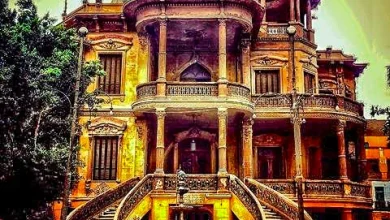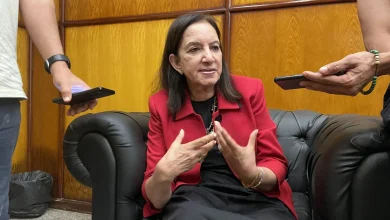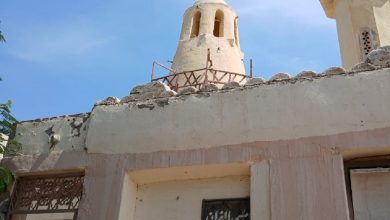“Port Said Lighthouse”.. The world’s first concrete structure at the crossroads of history and navigation
The Old Port Said Lighthouse
- Knowledge is power
- The Future Of Possible
- Hibs and Ross County fans on final
- Tip of the day: That man again
- Hibs and Ross County fans on final
- Spieth in danger of missing cut
In the heart of Port Said stands the ancient Port Said Lighthouse, a testament to engineering genius and navigational vision for more than 160 years. It is not just a lighthouse, but the world’s first large concrete structure and one of the most prominent heritage and historical landmarks worthy of inclusion on the global tourism map. The lighthouse continued to play a pivotal role in guiding ships passing through the Suez Canal until it ceased operations in 1997, after serving global navigation for more than a century and a half.
Port Said Lighthouse: a towering beacon at the edge of the world

On April 23, 2025, Major General A.H. Mahb Habashi, Governor of Port Said, announced the launch of a comprehensive plan to develop the old Port Said lighthouse and the surrounding area. The governor pointed out that the development work will focus on preserving the historical architectural character of the lighthouse, which is one of the oldest lighthouses in the Mediterranean basin, while implementing qualitative improvements to the infrastructure in the surrounding area. The plan includes continuing the development of the tourist walkway overlooking the Suez Canal on Palestine Street, to integrate heritage with modernity. This will contribute to enhancing the visitor experience and achieving sustainable tourism.
The governor of Port Said emphasized that the project will be carried out in accordance with the highest quality standards and will preserve the environmental and aesthetic character of the area. This will make the Port Said lighthouse a shining point on Egypt’s heritage tourism map.

The Old Port Said Lighthouse is located in the Sharq neighborhood, or the French Quarter as it was formerly known, the oldest and most prestigious neighborhood in the governorate. The lighthouse’s main facade faces east onto Palestine Street (formerly Sultan Hussein Street), overlooking the navigable waters of the Suez Canal. To the west, it faces Memphis Street (formerly Mahmoud Sedki Street). To the north is Taif Street. To the south, it overlooks Al-Jabarti Street, near the inner end of the canal’s western breakwater.
Old Port Said Lighthouse
The Old Port Said Lighthouse was built on a base near the inner end of the canal’s western breakwater, surrounded by huge stones to repel waves from all sides when it was inaugurated. It still retains its original layout despite the additions that have been made to it. The lighthouse tower and its annexes face eastward toward Port Said on Palestine Street (formerly Sultan Hussein Street).

The lighthouse is considered a unique example of 19th-century architecture in Port Said.
It was built during the reign of Khedive Ismail in June 1869 and began operating in February 1870, before ceasing operations in 1997. Dr. Mohamed Shajar, who has been interested in the history and heritage of Port Said for more than two decades, told Bab Masr – Bahri:
“From the moment the Suez Canal was first dug, specifically on April 25, 1859, French engineer Ferdinand de Lesseps had a clear vision of the importance of having a lighthouse in Port Said to guide ships and facilitate navigation. He began by directing the construction of a primitive wooden lighthouse about 20 meters high, with a range of about 25 miles, which met the needs at the time.”
Lighthouses of Port Said
With the opening of the Suez Canal in 1869, there was an urgent need to expand the maritime lighting system along the northern coast of Egypt, from Port Said to Alexandria. The decision was made to build four main lighthouses in Rosetta, Burj, Izbat al-Borg, and Port Said.
However, what distinguished the Port Said lighthouse from the other three was that it was built using reinforced concrete, while the rest were made of iron. The construction was entrusted to the Connie Contracting Company, headed by French engineer François Connie, one of the first to use reinforced concrete on such a large scale.
The Port Said lighthouse is a unique engineering achievement, constructed using a mixture of cement reinforced with iron strips, stacked on top of each other to form an octagonal structure 56 meters high.
The Suez Canal shipping lane
The lens is about 5 meters high and overlooks the Suez Canal shipping lane from its eastern side. Its walls are covered in black and white and topped with a wooden structure crowned by a black “ball.”
This “black ball” was not just decoration, but an important warning signal for ships coming from the north and south through the canal. This was especially important when the passage was narrow and surrounded by islands. It rose and fell with the rising steam as a signal for the start of maritime convoys at specific times. These were 7 a.m., 12 noon, and 4 p.m.
These signals were linked to workers at the naval arsenal, which was part of the Suez Canal Authority, who used to ask, “Where is the bell? Up or down?” to determine their break times and when to leave work.
The Port Said lighthouse is a global symbol
Dr. Mohamed Shajar explained with obvious joy: “Now we are hearing about a project to develop the lighthouse and the surrounding area. This is what we have been dreaming of and striving for. This lighthouse is not only a local heritage site, but also a global symbol. As the first concrete structure of this magnitude, it still stands today, proof of the success of Connie’s theory of concrete construction.”
Shajar pointed out the importance of including the Port Said lighthouse on the global tourism map, citing the voyages of Thomas Cook, who chose Port Said as an important stop on his tour from England to India. The tour included landmarks such as the Eastern Exchange Hotel. He added:
“This is the ambition, for Port Said to become a global tourist attraction and for its historic lighthouse to be included as one of the most prominent attractions.” He praised the comprehensive development work on François Joseph Street, considering it a successful model for the transformation of tourism in Port Said.
He suggested that the street be converted into an open museum, combining architectural and heritage beauty. It would attract both domestic and foreign tourism.
Read also:
“The Victory Museum of Modern Art”… Port Said’s memory in paintings and sculptures





Hi, this is a comment.
To get started with moderating, editing, and deleting comments, please visit the Comments screen in the dashboard.